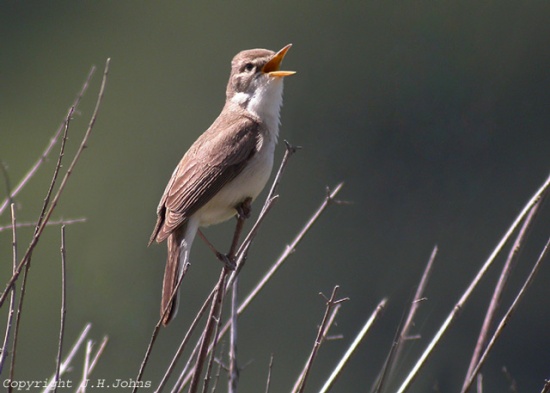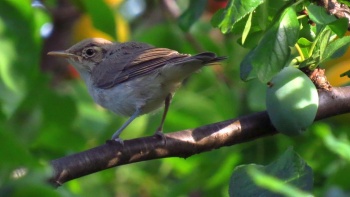Alternative name: Olivaceous Warbler
- Iduna pallida
Hippolais pallida
Identification
Total length 12–14 cm (4¾-5½ in), weight 8-16 g
Bill rather long and forehead "flat". Tail relatively long and square-ended (sides rounded). Primary extension ca. ½ tertial-length. Dull greyish-brown above, whitish below with a dull greyish-brown tinge to flanks and chest. Eye-ring, lores and poorly marked supercilium buffy-white. Upper mandible blackish, lower dull orange-yellow.
Similar species
Western Olivaceous Warbler is slightly larger, heavier-billed and browner, while Sykes's Warbler and Booted Warbler are slightly smaller, lighter-billed, and paler.
Distribution
Breeds from the Balkans east through Greece, Crete, Cyprus, Turkey, Middle East, the Caucasus, to Iran and Afghanistan. In Africa it breeds at oases throughout the Sahara Desert from southern Morocco, Algeria, Tunisia, northern Libya, south to northern Nigeria, and east in the Nile Delta and Valley and at scattered oases in the west of Egypt; separated from Western Olivaceous Warbler by the Atlas Mountains.
Winters in central and eastern Africa, and southwestern Arabian peninsula. Leave breeding grounds in July-September and return in April-May. Resident or only with local movements in Northern Somalia and parts of central, north-central and north-eastern Africa.
Vagrants have been recorded widely in the Western Palearctic in the British Isles, France, Germany, Sweden, Finland, Czechoslovakia, Italy, Malta, Canary Islands, Madeira and the Cape Verde Islands. Apart from Iberia, it is more frequent in Europe than Western Olivaceous Warbler.
Several older British records have been rejected after a recent review but those that remain (c.17) have been referred to this species. Most British records have been in the south-west in September-October although there have been records from the Northern Isles and the east coast.
Taxonomy
It was formerly considered conspecific with Western Olivaceous Warbler and was, along with the other species of Iduna, included in the genus Hippolais.
Subspecies
There are 4 subspecies[2]
- I. p. elaeica breeds in southeast Europe to Iran and southwest Asia, winters to northeast Africa
- I. p. pallida breeds in Egypt, south through Western Desert oases the Nile Valley to central Sudan; winters Sudan, Eritrea, and Ethiopia
- I. p. reiseri breeds in the Sahara in Algeria, southern Morocco, Mauritania and Libya
- I. p. laeneni in the Sahel in Niger, Chad, Nigeria and to western Sudan
A Birdforum discussion includes statements that subspecies I. p. reiseri is vocally distinct from both Western and Eastern Olivaceous Warbler.[4].
Habitat
Wide range of wooded and brushy habitats. Prefers areas with some tall trees and dense undergrowth, but avoids closed forest. Often near water. Fairly common in most of its range.
Behaviour
When foraging, often flicks its closed tail up-and-down; a habit lacking in Western Olivaceous Warbler.
Diet
Feeds on insects and spiders. To a lesser extent also fruits (mostly in late summer). Generally feeds at high levels, but sometimes lower on migration.
Breeding
Breeding season from May to June. The nest is a cup made of plant-material placed fairly low in the fork of a branch. The 3-5 eggs are incubated by the female, but both parents feed the nestlings. A single brood in Central Asia and Europe, probably double-brooded in Africa.
Movements
Subspecies elaeica is a long-distance migrant. Birds of northern Africa move south of the Sahara and spend the non-breeding season in the Sahel zone. Birds in the south of the range are resident or undertake only short movements.
Vocalisation
References
- Dickinson, EC, ed. 2003. The Howard and Moore Complete Checklist of the Birds of the World. 3rd ed., with updates to October 2008 (Corrigenda 8). Princeton: Princeton Univ. Press. ISBN 978-0691117010
- Clements, J. F., T. S. Schulenberg, M. J. Iliff, S. M. Billerman, T. A. Fredericks, B. L. Sullivan, and C. L. Wood. 2019. The eBird/Clements Checklist of Birds of the World: v2019. Downloaded from http://www.birds.cornell.edu/clementschecklist/download/
- Gill, F, M Wright and D Donsker. 2009. IOC World Bird Names (version 2.0). Available at http://www.worldbirdnames.org/.
- Handbook of the Birds of the World Alive (retrieved February 2017)
- Birdforum thread with links to pictures of different forms of Olivaceous Warbler
Recommended Citation
- BirdForum Opus contributors. (2024) Eastern Olivaceous Warbler. In: BirdForum, the forum for wild birds and birding. Retrieved 27 July 2024 from https://www.birdforum.net/opus/Eastern_Olivaceous_Warbler
External Links
GSearch checked for 2020 platform.1






